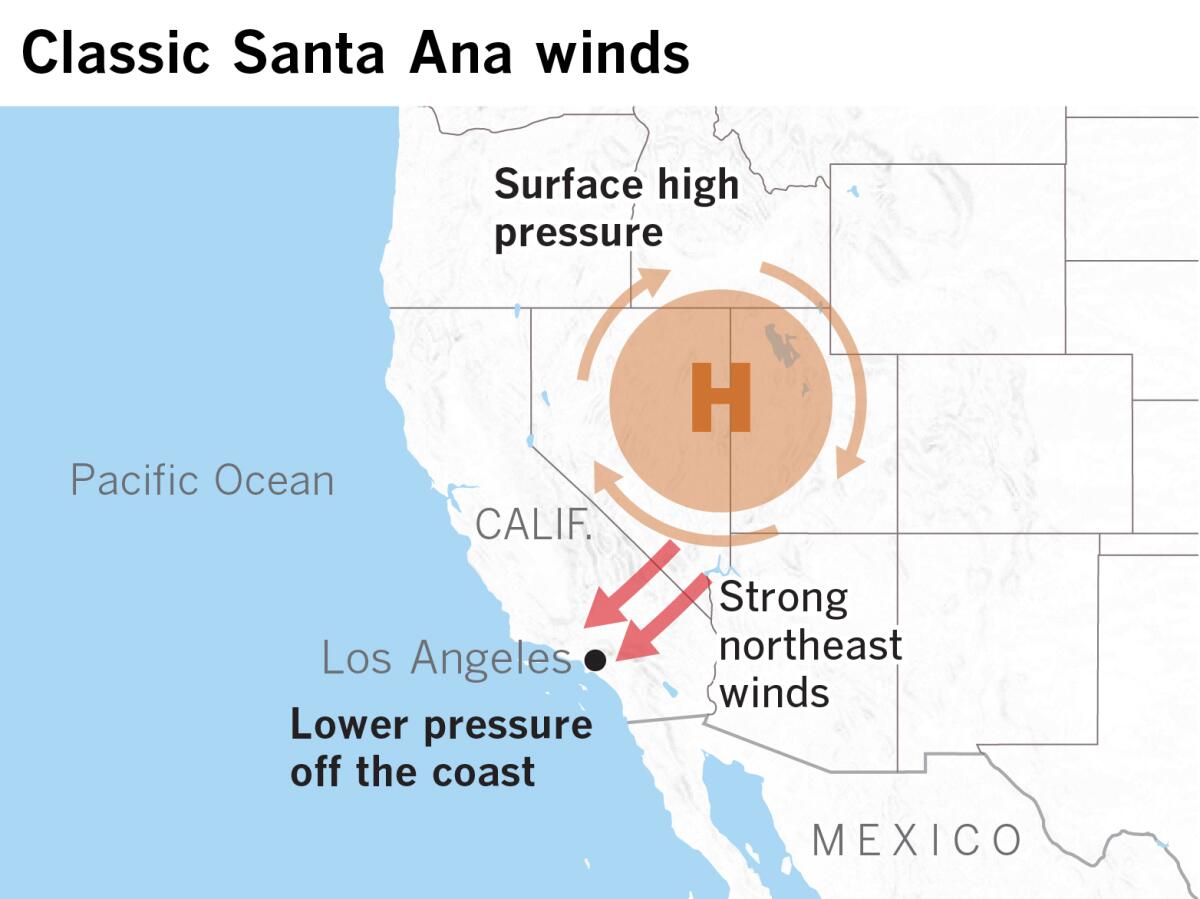Rare ‘particularly dangerous’ fire warning issued for Southern California

- Share via
With exceptional fire weather conditions forecast starting Monday night, the National Weather Service office issued a rare “Particularly Dangerous Situation” red flag warning to last through Tuesday in Los Angeles and Ventura counties.
The last time a Particularly Dangerous Situation red flag warning was issued for the area was just a month ago, on election day, when forecasters warned of extreme fire weather behavior. A day later, on Nov. 6, the Mountain fire ignited in Ventura County and, whipped by powerful winds, razed more than 240 buildings. It became the third-most-destructive wildfire in Southern California since 2013.
Before November, the last time a Particularly Dangerous Situation red flag warning was issued by the National Weather Service office for L.A. and Ventura counties was in 2020, the first year those alerts existed for the region.
National Weather Service meteorologist Robbie Munroe said Particularly Dangerous Situation red flag warnings should, on average, occur only once every three to five years. But it has now happened twice in the same fire season, just as it did in 2020 — once in October and another time in December.
Munroe warned that the “Particularly Dangerous Situation” conditions were expected to start around 8 p.m. Monday and last through 2 p.m. Tuesday. He said the extreme fire weather could be “similar in magnitude” to the howling Santa Ana wind event on Nov. 5 and 6 that fueled the Mountain fire.
In just a few terrifying hours, the Mountain Fire became the most destructive blaze in Southern California in years. The conditions were ripe for disaster, and neighborhoods had few defenses. Here is what happened.
Fire weather conditions were expected to be “extreme” and “extraordinary,” Munroe said. “This is a very dangerous situation, with the potential for large and dangerous, life-threatening fires, should a fire ignite.”
The winds were expected to ramp up as early as 4 p.m. Monday.
The windy, dry and vegetation-dessicating conditions also are similar to those that kindled the Thomas fire of 2017, Southern California’s second-most-destructive fire since 2013, which destroyed more than 1,000 structures in Ventura and Santa Barbara counties. (The region’s most destructive fire in that time frame was the Woolsey fire of 2018, which destroyed more than 1,600 structures in Los Angeles and Ventura counties.)
What makes this week’s weather forecast so dangerous?

A key focus for forecasters during this wind event will be the traditional Santa Ana wind corridors of Los Angeles and Ventura counties.
Santa Ana winds form around this time of year when a system of high pressure builds in the Great Basin — over Nevada and Utah — and then seeks a release valve off the coast, where there is low pressure.
Valleys and canyons can transform into wind tunnels in these extreme conditions. Sinking wind blows at high speeds en route to the beaches, generally in a northeast-to-southwest direction. With gusts of up to 80 mph possible, a small fire could transform into an inferno, whipping embers at astonishing speeds and leaving firefighters with few options other than trying to get people to evacuate.

A Santa Ana wind corridor to watch will be that of the Santa Clara River Valley, which essentially funnels air sinking from a high pressure area above the high desert to the Ventura County coast by way of Santa Clarita.
“Rapid-fire spread is anticipated with any new fire in these wind corridors,” Munroe said. “The damaging winds will also likely lead to scattered downed trees, power lines and power outages.”
Areas within the Particularly Dangerous Situation include large swaths of Ventura County, such as Thousand Oaks, Ventura, Oxnard, Fillmore and Ojai, as well as places like Malibu, Canoga Park, Santa Clarita and Acton in L.A. County.

Boaters should be aware of the extreme winds, which are expected to be strongest in the area extending from Ventura to Malibu and offshore to the Channel Islands. Strong winds are also expected from San Pedro Channel to Santa Catalina Island. Waves of 6 to 8 feet and coastal flooding could hit east-facing harbors, such as those on Catalina Island, Munroe said.
The criteria to issue a red flag warning that’s a Particularly Dangerous Situation include a forecast of sustained winds of at least 35 mph and/or gusts of at least 60 mph, single-digit relative humidity, and extremely dry vegetation.
There could be peak gusts of 31 mph in Canoga Park, 44 mph in Oxnard, 52 mph in Fillmore, 60 mph in Thousand Oaks and 64 mph in Santa Clarita. Munroe said there was a chance over the next two days that Southern California airports would be forced to delay flights due to strong winds.
Minimum relative humidity is expected to hit very low levels — as little as 1% in Oxnard and Thousand Oaks; 3% in Canoga Park, Ojai and Fillmore; 6% in downtown L.A. and Santa Clarita; 7% in Covina and 11% in Long Beach.
A regular red flag warning — which means the National Weather Service has high confidence that dangerous fire conditions will materialize — is expected to be issued for a larger portion of Southern California starting late Monday morning, including the San Fernando and San Gabriel valleys; the Palos Verdes Peninsula; the Grapevine section of Interstate 5; the San Luis Obispo County mountains; the Inland Empire and large swaths of San Diego County.
After the wind event, there’s not too much hope for significant rain for Los Angeles and Ventura counties. There could be some light amounts in Santa Barbara and San Luis Obispo counties, Munroe said, but even that is “unlikely to be much help for any possible fires that start early this week.”
“We’re not seeing any significant rain prospects for L.A. area for the next week,” Munroe said. “We’ll probably remain dry.”

More to Read
Sign up for Essential California
The most important California stories and recommendations in your inbox every morning.
You may occasionally receive promotional content from the Los Angeles Times.











